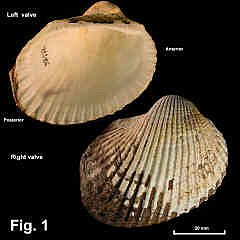|
|
ARCIDAE |
|
|
|
Anadara trapezia (Deshayes, 1840) Description: Solid, heavy, equivalve, inequilateral. Shape elongate, umbones in front of midline, elevated, widely separated. Hinge line straight. Posterior end extended, broadly rounded; anterior end broadly rounded. Ventral margin smoothly rounded, byssal notch absent. Hinge with 40-50 teeth. Ligament external. Interior margin coarsely crenulated, muscle scars clearly defined, roughly circular, white. Exterior sculpture of strong radial ribs, often crossed by coarse growth breaks. Periostracum thick, dark brown. Shell colour white, in life obscured by periostracum. Size: Up to 65 mm in length. Distribution: Living specimens occur from Townsville, Qld, southwards to Port Phillip Bay, Vic, with an isolated population at Oyster Harbour near Albany, WA. The fossil record shows that the distribution of the species was wider in the past, when it also lived in western Victoria, South Australia, Tasmania and northern New Zealand. Ludbrook (1894) reported that the species was abundant in South Australia in the Late Holocene (i.e., more than 10,000 years ago). The solid, thick shells are long-lived as fossils, and some reported distributions do not differentiate between living and fossil shells. Habitat: Lives in estuaries on and shallowly buried in mud or sandy mud. Common. Comparison: Teguillarca granosa (Linnaeus, 1758) is a similar species that occurs in the tropical Indo-west Pacific region, including Queensland. The shell is less elongate than A. trapezia and has nodulose radial ribs. Empty shells, probably fossil, have been found uncommonly on Sydney beaches. Fig. 1: Merimbula, NSW (C.070585)
|
|
